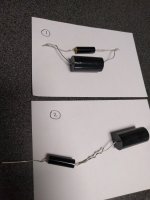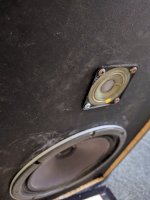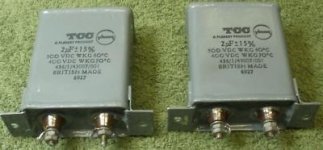Hi.
I'm refurbishing a pair of 2 way Interdyn Loudspeakers.
Internally these use 3.7µF Caps for the tweeters.
I have a pair of 3.3 µF Caps, and a pair of 0.47µF Caps which = 3.77 µF.
If I fit these in series will this get me over the line or is a 0.07 µF variation too much?
The poly caps are + - 5%, and the electrolytic Caps I'm removing are = - 10%.
Thanks
Cliff
I'm refurbishing a pair of 2 way Interdyn Loudspeakers.
Internally these use 3.7µF Caps for the tweeters.
I have a pair of 3.3 µF Caps, and a pair of 0.47µF Caps which = 3.77 µF.
If I fit these in series will this get me over the line or is a 0.07 µF variation too much?
The poly caps are + - 5%, and the electrolytic Caps I'm removing are = - 10%.
Thanks
Cliff
Tolerences of plus or minus 5% are quite acceptable in all but the most critical of crossover applications, Cliff.
5% of 3.7uF = 0.2uF (approximately).
So anywhere between 3.5uF and 3.9uF is OK.
5% of 3.7uF = 0.2uF (approximately).
So anywhere between 3.5uF and 3.9uF is OK.
Last edited:
If I fit these in series will this get me over the line or is a 0.07 µF variation too much?
That's in parallel, not in series. Just the 3.3uF is enough though, since it's only 10% off.
Last edited:
Yes, Cliff, +/- 10% is good enough in my book, but I've been told off for suggesting that in this forum.
Glad that rayma says 10% is OK, and I agree that you can just use the 3.3uF or go for the parallel combination if you wish.
Glad that rayma says 10% is OK, and I agree that you can just use the 3.3uF or go for the parallel combination if you wish.
Last edited:
Thanks Guys.
I'm not the best with terminology.
If I did use both Caps would I wire them end to end, I thought this means series?
Which example in the photo is "series"?
The tweeter used in the Interdyn's looks pretty small and delicate.
I get that 10% variation can be acceptable.
When these caps were originally selected many years ago, couldn't 10% variation have been either a cost measure, or an availability issue?
Or is 5% variation of 3.3 very close to a 10% variation of 3.7?
I don't want any compromise in sound reproduction and I have the hardware.
Any final thoughts?
thanks
I'm not the best with terminology.
If I did use both Caps would I wire them end to end, I thought this means series?
Which example in the photo is "series"?
The tweeter used in the Interdyn's looks pretty small and delicate.
I get that 10% variation can be acceptable.
When these caps were originally selected many years ago, couldn't 10% variation have been either a cost measure, or an availability issue?
Or is 5% variation of 3.3 very close to a 10% variation of 3.7?
I don't want any compromise in sound reproduction and I have the hardware.
Any final thoughts?
thanks
Attachments
Last edited:
Side by side (top photo) is 'in parallel' and that's what you need - capacitors in parallel add - opposite rule from resistors.
As to the rest, you are overthinking this. Just go by our recommendations.
As to the rest, you are overthinking this. Just go by our recommendations.
If the originals are 3.7uF, then 3.3 and 0.47 in parallel to make 3.77uF sounds good to me.
Most generic plastic film caps are within 5 or 10% tolerance i.e. your '3.3uF' capacitors may be as low as 3.0uF or as high as 3.6uF. That doesn't make it good idea to replace a '3.7uF' with a '3.3uF' because you may actually be replacing a cap that is exactly 3.7uF with one that is actually 3.0uF and you're 19% off.
Ideally you'd buy a bunch of capacitors and measure the capacitance with a capacitance meter, to select the exact value you need, or buy capacitors that are specified with a tight tolerance (1%).
Most generic plastic film caps are within 5 or 10% tolerance i.e. your '3.3uF' capacitors may be as low as 3.0uF or as high as 3.6uF. That doesn't make it good idea to replace a '3.7uF' with a '3.3uF' because you may actually be replacing a cap that is exactly 3.7uF with one that is actually 3.0uF and you're 19% off.
Ideally you'd buy a bunch of capacitors and measure the capacitance with a capacitance meter, to select the exact value you need, or buy capacitors that are specified with a tight tolerance (1%).
Yes, Cliff, +/- 10% is good enough in my book, but I've been told off for suggesting that in this forum.
Glad that rayma says 10% is OK, and I agree that you can just use the 3.3uF or go for the parallel
combination if you wish.
Both speakers should be matched closely, that's more important than the absolute tolerance.
Electrolytic capacitors vary all over the map, degrade, and wear out. A lot of drivers aren't that much better.
Was it just a single high pass capacitor on that paper cone tweeter, Cliff?
You should note TMM's last paragraph about actually measuring the capacitance of your capacitors.
Have you not bought that LCR meter yet? I'm sure I recommended one to you some time ago.
You should note TMM's last paragraph about actually measuring the capacitance of your capacitors.
Have you not bought that LCR meter yet? I'm sure I recommended one to you some time ago.
Differences in % of values of various xo components are hardly audiable, but the electrolytes are significant, so put your money there. Change (% value) does change the xo frequency, but regard your LS as an assemble of electric, mechanic and acoustic components within the range of the xo components. 0.07µ/3.77µ = 2%, inaudiable.
That's in parallel, not in series. Just the 3.3uF is enough though, since it's only 10% off.
Hi Rayma
Was hoping to learn more about decision making rather than just the answer.
The Interdyn Model 212 Loudspeakers I'm restoring are atleaset 40 years old.
They are an infinite baffle design with 50 watts, 8 Ohm impedance & 90Db sensitivity.
The designers specified 3.7uF.
Is it possible that caps with a +- 10% variation were selected at the time due to availability and cost restraint issues?
Is it possible that caps of that era with better than 10% tolerances were prohibitive in price?
If I fit 3.3uF caps with a 5% variance this means, worse case scenario it will be running at 2.97uF which is appreciably different to the specified 3.7uF.
The tweeters on this model are quite small in size and maybe sensitive.
Can I ask the thought process of recommending 10% variance, especially when we have a different starting point (3.3 vs 3.7)?
Don't think of it as splitting hairs, but more a learning process.
thanks
Cliff
.
Last edited:
Differences in % of values of various xo components are hardly audiable, but the electrolytes are significant, so put your money there. Change (% value) does change the xo frequency, but regard your LS as an assemble of electric, mechanic and acoustic components within the range of the xo components. 0.07µ/3.77µ = 2%, inaudiable.
What about 2.97uF. vs 3.77uF, is this audible?
Or 2.97uF. vs 4.07uF, is this audible?
Even a few % off is very audible for something like a notch filter designed to quell a narrow driver breakup spike. It may make the notch miss its target frequency completely.
For a lowpass/highpass filter it is less important. 5-10% off will still give you perhaps a 0.5-2dB change at the crossover point which is audible but probably not immediately noticeable unless you are well trained to how it should sound with the nominal value. The sound will be brighter or darker or forward or recessed compared to the nominal value. Directivity may suffer as the drivers may not align precisely in phase as designed.
3uF vs 3.7uF is too much imho. 3.7uF vs 3.8uF is acceptable (within 5%). Armed with a capacitance meter and a bunch of capacitors i'd try to pick pairs that make up 3.65-3.75uF (within 2%).
For a lowpass/highpass filter it is less important. 5-10% off will still give you perhaps a 0.5-2dB change at the crossover point which is audible but probably not immediately noticeable unless you are well trained to how it should sound with the nominal value. The sound will be brighter or darker or forward or recessed compared to the nominal value. Directivity may suffer as the drivers may not align precisely in phase as designed.
3uF vs 3.7uF is too much imho. 3.7uF vs 3.8uF is acceptable (within 5%). Armed with a capacitance meter and a bunch of capacitors i'd try to pick pairs that make up 3.65-3.75uF (within 2%).
Last edited:
It is more important that the two speakers are the same, don't have 3.3 in one and 3.7 in the other
Was the original part plastic or electrolytic?
Changing electrolytic to a plastic can have unfortunate effects if the original designer used the higher ESR in their voicing
Was the original part plastic or electrolytic?
Changing electrolytic to a plastic can have unfortunate effects if the original designer used the higher ESR in their voicing
The cap can be part of the crossover or a protection then there is no need for an accurate value.Was hoping to learn more about decision making rather than just the answer
.
I hope this helps: PROTECT YOUR TWEETERS! Capacitors and WHY you need them - YouTube
Just consider that 40 years ago 10% elctrolytics were INCREDIBLY good and not common at all.Is it possible that caps with a +- 10% variation were selected at the time due to availability and cost restraint issues?
Believe it or not, plain vanilla electrolytics were -30%/+50% , go figure.
Maybe those meant for crossovers could be specified something closer ... 20%?
10% was usually not heard of.
That said, IF Tweeter crossover is just a single cap in series, slope is so shallow as to make cap precision quite relaxed anyway.
Meaning: don´t overthink it.
In the 1950s, paper in oil capacitors with 10 to 20% tolerance were used in crossover networks, but the larger values were expensive. Paper in oil capacitors in the 12 to 25uF range cost around £2 - that's equivalent to around £50 today!Is it possible that caps of that era with better than 10% tolerances were prohibitive in price?
By the early 1960s, progress had been made in the design of bipolar electrolytic capacitors that could be guaranteed to be within +/- 20% of their rated value. Values in the range 12 to 25uF cost around 5 shillings in 1963 - that's equivalent to £5 today - a considerable cost saving over the paper in oil types!
Attachments
- Home
- Design & Build
- Parts
- Advice on µF Variation to Loudspeaker specs?


